
by Laura Tiu | Mar 11, 2022
World Wildlife Day was celebrated on March 3, 2022. This year’s theme is “Recovering key species for ecosystem restoration.” We celebrate this day to bring attention and awareness to many of the plants and animals that are considered threatened and endangered species and highlight efforts to conserve them. It is estimated that over a million species are currently threatened with extinction.
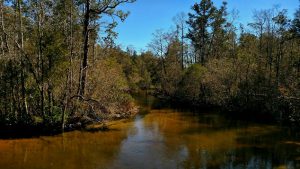
Turkey Creek Niceville, FL (credit E. Zambello)
Florida is considered a very biodiverse state having a great variety ecosystems and unique plants and animals that inhabit these areas. This makes Florida an attractive place to live but can result in increased pollution and land use changes that can be threats to this biodiversity. One local species that experienced this type of pressure is the Okaloosa darter. This tiny 1 to 2 inch fish dwindled to as few as 1,500 individuals surviving when it was declared endangered in 1973. Factors such as its small range, competition from other species, and historical land use practices including artificial impoundments, erosion, and siltation, contributed to its demise.
The Okaloosa darter prefers to live in small, clear, lightly vegetated streams fed by ground water seepage from sand hill areas. This highly specialized habitat is found in only six streams in Okaloosa and Walton Counties and almost exclusively within Eglin Air Force Base’s boundaries. Environmental managers from Eglin Air Force Base partnered with U.S. Fish and Wildlife Service and other agencies and worked diligently to reduce land use impacts and rehab the impaired streams over the past several decades. They reclaimed clay pits near stream headwaters, improved road crossings to reduce sedimentation and enhanced the habitat for the darter.
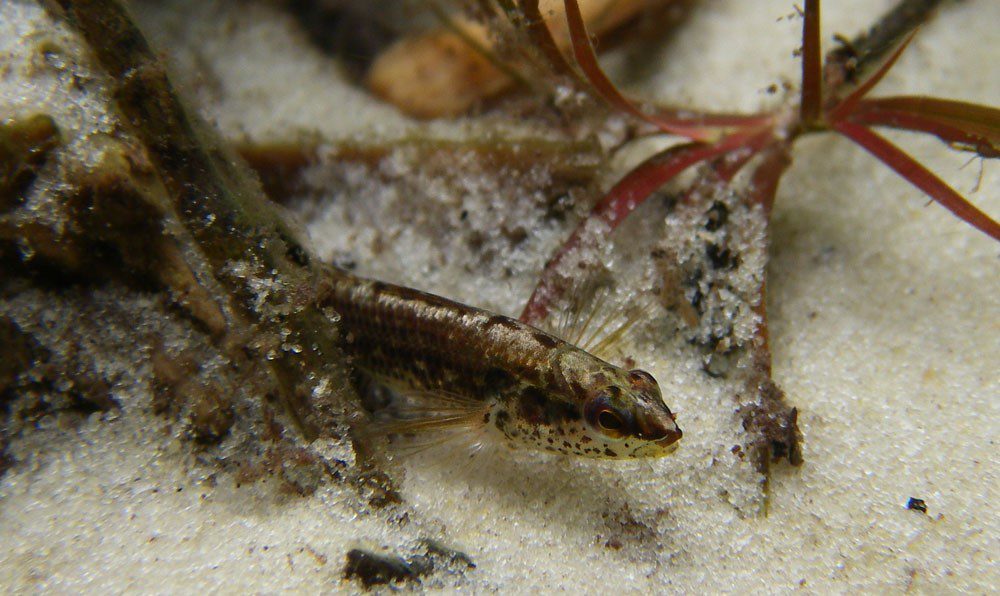
Okaloosa darter photo credit: FWS.gov
Due to these efforts, the population of Okaloosa Darters has increased to more than 600,000 and the species has now been down listed from endangered to threatened. In fact, the projects have been so successful that the darter is now being considered for delisting as a threatened and endangered species under the Endangered Species Act. This is something to celebrate on this World Wildlife Day as an example of how we can recover key species for ecosystem restoration. The best news is that Eglin Air Force Base’s Jackson Guard Unit is continuing to make on-base conservation a priority, not only for the Okaloosa Darter, but for other plants and animals under their purview.

by Laura Tiu | Jan 27, 2022
February is American Heart Month and when I think of heart, my thoughts turn to seafood. Perhaps that is unusual, but I love seafood and the fact that the American Heart Association recommends 1 to 2 seafood meals a week fits right into my gastronomic plans. More seafood on your table can improve your overall health and help fight off infections.
During the recent pandemic, an increase in home cooking has resulted in a rise in seafood consumption. Consumers rediscovered frozen and canned fish, a trend that continues today. Canned tuna and fish stick consumption rose as home cooks perfected their tuna melts and fish sandwiches. Home chefs throwing fish steaks, aluminum wrapped fillets, shrimp, and even oysters on the grill have raised the bar on home-cooked meals.
Other new trends on the horizon are more innovative. How do Atlantic salmon hot dogs sound? High-end canned and jarred seafood, think canned smoked oysters, are gaining in popularity as well as being quick and easy to prepare. Nose to tail is another trend that promotes maximum utilization of the whole seafood product. Cooking fish whole or tanning fish skins for an upscale leather are new ways to enjoy seafood. Want to try something new? Sea vegetables, including kelp and other seaweed are taking the culinary world by storm because of their great taste and nutritional benefits.
Let us not forget about our furry friends. Sustainable seafood-based pet treats are gaining quite a bit of market share. Seafood has one of the lowest environmental footprints of any protein, and as such makes a great, healthy, sustainable snack for fido.
Sustainable seafood, both wild and farm-raised, is an option that is good for your heart and good for the planet. Buying sustainably harvested or raised seafood is one way you can do your part to protect the ocean and ensure plentiful seafood for the future. Make a resolution to try a new product, recipe, or cooking method during this month to celebrate a healthy heart.
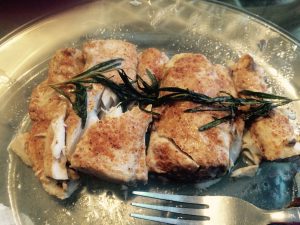
Cooked red snapper (Photo credit: L. Tiu)

by Laura Tiu | Dec 2, 2021
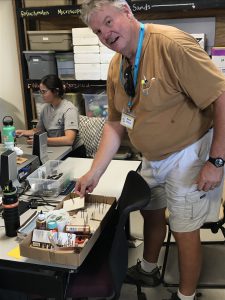
Florida Master Naturalist Student and Florida State Park Ranger, Bruce Williams, prepares for his snowy plover lesson.
There is an oft quoted proverb “those who can’t do, teach.” It is meant to be humorous, but it couldn’t be farther from the truth. Teachers of all kinds have enormous impacts on our lives. For graduates of the Florida Master Naturalist Program (FMNP) there is a line in the mission statement that reads “The FMNP teaches those who teach others about Florida’s unique ecosystems and wildlife.” In fact, to graduate, FMNP students must complete a project and present, or teach, it to the class.
A good teacher, like a good entertainer first must hold his audience’s attention, then he can teach his lesson (John Henrik Clarke). In a recent coastal class, we had the good fortune of having a State Park Ranger as a student. His job requires him to do interpretive education at the park, so he had quite a bit of experience under his belt. His project, a craft project involving the assembly of a cute snowy plover chick, was his way of holding his audience’s attention while he talked of the importance of preserving and protecting habitat for shorebirds.
I thought the project and message was impressive and worthy of sharing. To all of you teachers out there who work to make our lives and world better, thank you, and here is another great activity to add to your quiver. If you would like more information on the Florida Master Naturalist Program go here: https://masternaturalist.ifas.ufl.edu.
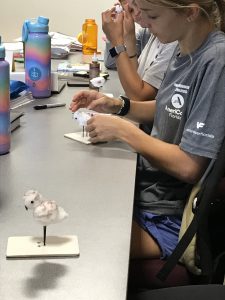
Making cotton ball snowy plover chicks
Group Project: Make a Snowy Plover Chick (Peipert, 2011)
This project is suitable for Elementary age through Middle school age children. It is recommended when doing project with a class or large group that some preparation is done ahead of time.
Supplies:
corrugated cardboard (disassembled brown packing box will do)
1 bag of cotton balls
1 container of black glass beads (sold at craft stores)
black sunflower seeds
1 container of wood toothpicks (kind with one end blunt)
1 can of black spray paint
several of each black, brown & gray markers
several bottles of quick dry tacky glue (sold at craft stores)
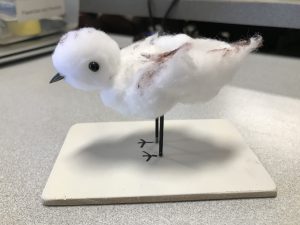
Cotton ball snowy plover chick craft
Preparation:
- Using an exacto or carpet knife and T-square cut corrugated cardboard into 3”x3” squares for the # of stands needed. To complete stand preparation, write Snowy Plover chick on stand, draw a pair of feet in center of stand and pierce cardboard in center of feet. This step is a real time saver and recommended for young children.
- Paint toothpicks with black spray paint for legs, easiest way to do this is by taking toothpicks and sticking them into a spare piece of cardboard upright them paint.
Instructions: (skip to instruction #3 if using stands with feet & holes premade)
- Draw a pair of bird feet on center of cardboard and if you want write” Snowy Plover chick” on cardboard.
- Use the pointed end of a toothpick to make a hole in the center of drawn feet. Then put the blunt end of toothpicks in the holes and put a heavy glob of glue around them. Don’t be shy with the glue, it will dry clear and will be better support.
- Take one of the cotton balls and roll around between hands to make it smaller. This will be the head. Next using all three or two markers make many dots on one side of both cotton balls creating a speckled pattern.
- Put a glob of glue at top of each toothpick and put larger cotton ball (the body) on top of toothpicks pushing down so the glue is covered by the cotton ball. Next put a glob of glue on the top of body and put white side of cotton ball (the head) on glue.
- To complete the chick put a small glob of glue on opposite sides of head then place glass beads on. Lastly put a glob of glue on side of head that the feet are facing forward and place sunflower seed on with the pointed end facing out.
- Let stand for at least 15 minutes to dry before handling.
- Enjoy your Snowy Plover chick creation!
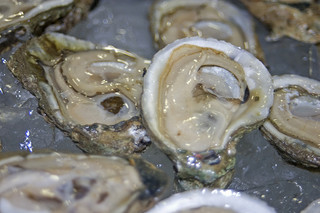
by Laura Tiu | Nov 19, 2021
There are a lot of good oyster quotes. One I remember from childhood is the saying to only eat oysters in months with the letter “r,” basically September to April. I believe this originated when all oysters came from the wild. This was a way to avoid the hot months that may have led to a watery oyster, or even food poisoning. Today, with the rise of oyster aquaculture and refrigeration, oysters can be enjoyed year-round.
The Florida Fish and Wildlife Conservation Commission recently made the tough decision to shut down wild oyster harvesting in Apalachicola, FL for up to five years in response to a struggling bay oyster population threatened by water flow issues and overharvesting. This was devastating news to an area that historically produced 90% of the state’s oysters and 10% of the nation’s. On the bright side, oyster aquaculture has been steadily growing in the area and is working hard to fill some of the gap.
A team of Florida Sea Grant Agents recently made a visit to Apalachicola to learn more about this historic oyster town and how the industry is adapting. Our first stop was Water Street Seafood, the Florida Panhandle’s largest seafood distributer. Water Street provides a wide diversity of both fresh and frozen seafood, including oysters, delivering daily in northwest Florida and shipping worldwide. We visited their oyster processing facility where we saw mesh bags of oysters brought in from Louisiana and Texas. The oysters, both farmed and wild caught, are carefully cleaned and sorted, with some going to the live, halfshell, restaurant market and some shucked onsite for the shucked market.
Next, we visited one of the many new oyster aquaculture farms in the area. Oysters farms are permitted by the state and are located in waters that have been carefully evaluated for their suitability for oyster production. Small plots are leased to the farmer allowing off-bottom production in mesh bags teathered with anchors in the shallow, productive bay waters. Oyster farmers tend to their crop by turning the bags regularly to reduce fouling of the oyster shell, and sorting by size as the oyster grows. Oysters take between eight to eighteen months to reach a harvest size.
Given the increasing demand for oysters by tourists and locals, we can thank aquaculture for keeping these tasty gems on our plates. If you are lucky enough to find some locally raised oysters on the menu, take the opportunity to try something new and support a local farmer.
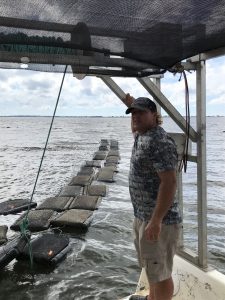
An oyster farmer visiting his lease to monitor his crop. (credit: L. Tiu)
T
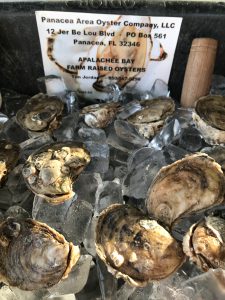
Fresh live oysters from an Apalachicola Oyster Farm (credit: L. Tiu)
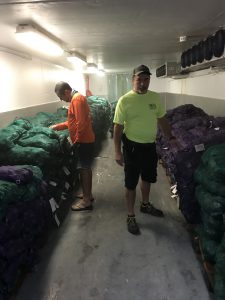
Oyster bag holding cooler at Water Street Seafood with green bags holding wild caught oysters and purple bags holding farm raised oysters. (credit: L. Tiu)

by Laura Tiu | Sep 9, 2021

A Lionfish Removal and Awareness Day festival volunteer sorts lionfish for weighing. (L. Tiu)
The northwest Florida area has been identified as having the highest concentration of invasive lionfish in the world. Lionfish pose a significant threat to our native wildlife and habitat with spearfishing the primary means of control. Lionfish tournaments are one way to increase harvest of these invaders and help keep populations down. Not only that, but lionfish are a delicious tasting fish and tournaments help supply the local seafood markets with this unique offering.
Since 2019, Destin, Florida has been the site of the Emerald Coast Open (ECO), the largest lionfish tournament in the world, hosted by Destin-Fort Walton Beach and the Florida Fish and Wildlife Commission (FWC). While the tournament was canceled in 2020, due to the pandemic, the 2021 tournament and the Lionfish Removal and Awareness Day festival returned to the Destin Harbor May 14-16 with over 145 tournament participants from around Florida, the US, and even Canada. The windy weekend facilitated some sporty conditions keeping boats and teams from maximizing their time on the water, but ultimately 2,505 lionfish were removed during the pre-tournament and 7,745 lionfish were removed during the two-day event for a total of 10,250 invasive lionfish removed. Florida Sea Grant and FWC recruited over 50 volunteers from organizations such as Reef Environmental Education Foundation, Navarre Beach Marine Science Station and Tampa Bay Watch Discovery Center to man the tournament and surrounding festival.
Lionfish hunters competed for over $48,000 in cash prizes and $25,000 in gear prizes. Florida Man, a Destin-based dive charter on the DreadKnot, won $10,000 for harvesting the most lionfish, 1,371, in 2 days. Team Bottom Time secured the largest lionfish prize of $5,000 with a 17.32 inch fish. Team Into the Clouds wrapped up the $5,000 prize for smallest lionfish with a 1.61 inch fish, the smallest lionfish caught in Emerald Coast Open History.
It is never too early to start preparing for the 2022 tournament. For more information, visit EmeraldCoastOpen.com or Facebook.com/EmeraldCoastOpen. For information about Lionfish Removal and Awareness Day, visit FWCReefRangers.com
“An Equal Opportunity Institution”















